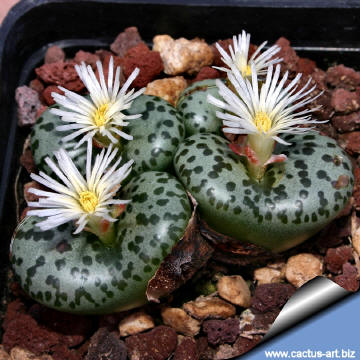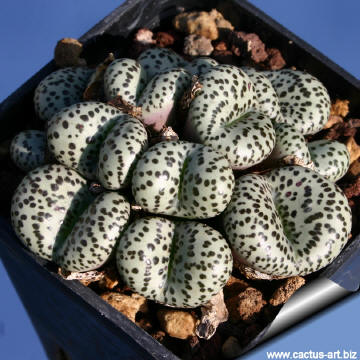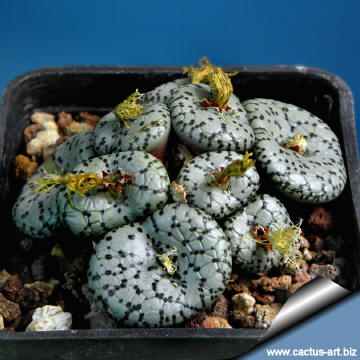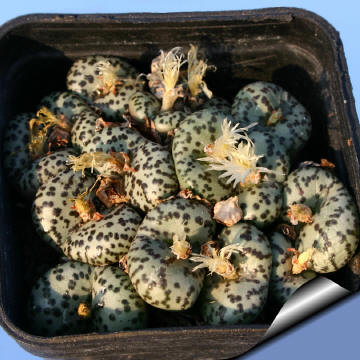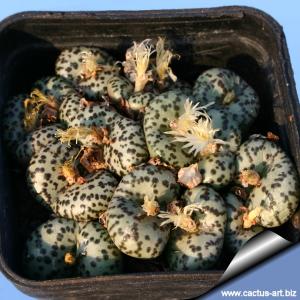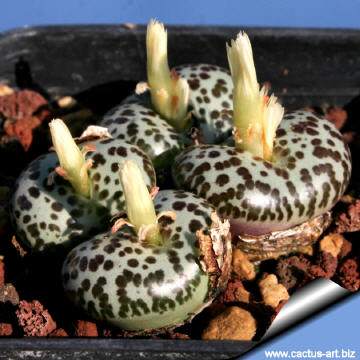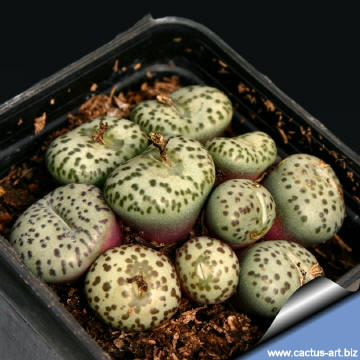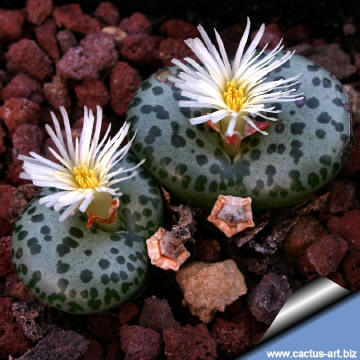Questa è una delle specie le più apprezzate con piccoli corpi ornati con da puntini scuri. I fiori sono notturni e squisitamente profumati. Con il tempo accestisce e forma grandi cespi con decine di teste.
Family: Mesebrianthemaceae (Aizoaceae) Scientific name: Conophytum obcordellum var. obcordellum (Haw.) N.E.Br. 1922
Origin: South Africa (Western Cape) Synonyms: - Conophytum declinatum L.Bolus 1937
- Conophytum germanum N.E.Br. 1933
- Conophytum giftbergense Tischer 1960
- Conophytum impressum Tischer 1957
- Conophytum klaverense N.E.Br. 1925
- Conophytum lambertense Schick & Tischer 1931
- Conophytum lambertense var. conspicuum Rawé 1971
- Conophytum longifissum Tischer 1927
- Conophytum multicolor Tischer 1928
- Conophytum mundum (N.E.Br.) N.E.Br. 1922
- Conophytum nevillei (N.E.Br.) N.E.Br. 1922
- Mesembryanthemum obconellum Haw. (1803)
- Conophytum obconellum (Haw.) Schwantes 1927
- Mesembryanthemum obcordellum Haw. 1803
- Conophytum obcordellum var. germanum (N.E.Br.) Rawé 1983
- Conophytum obcordellum var. mundum (N.E.Br.) Rawé 1983
- Conophytum obcordellum var. mundum f. picturatum (N.E.Br.) Rawé (1983)
- Conophytum obcordellum var. mundum f. ursprungianum (Tischer) Rawé 1983
- Conophytum obcordellum var. mundum f. stayneri (L.Bolus) Rawé 1983
- Conophytum obcordellum var. obcordellum f. declinatum (L.Bolus) Tischer 1969
- Conophytum obcordellum var. obcordellum f. multicolor (Tischer) Tischer 1969
- Conophytum obcordellum var. obcordellum f. picturatum (N.E.Br.) Tischer 1969
- Conophytum obcordellum var. parvipetalum (N.E.Br.) Tischer 1969
- Conophytum parviflorum N.E.Br. 1934
- Conophytum parvipetalum (N.E.Br.) N.E.Br. 1922
- Mesembryanthemum parvipetalum N.E.Br. 1920
- Conophytum picturatum N.E.Br. 1927
- Conophytum sparsum N.E.Br. nom. nud.
- Conophytum spectabile Lavis 1931
- Conophytum ursprungianum Tischer 1938
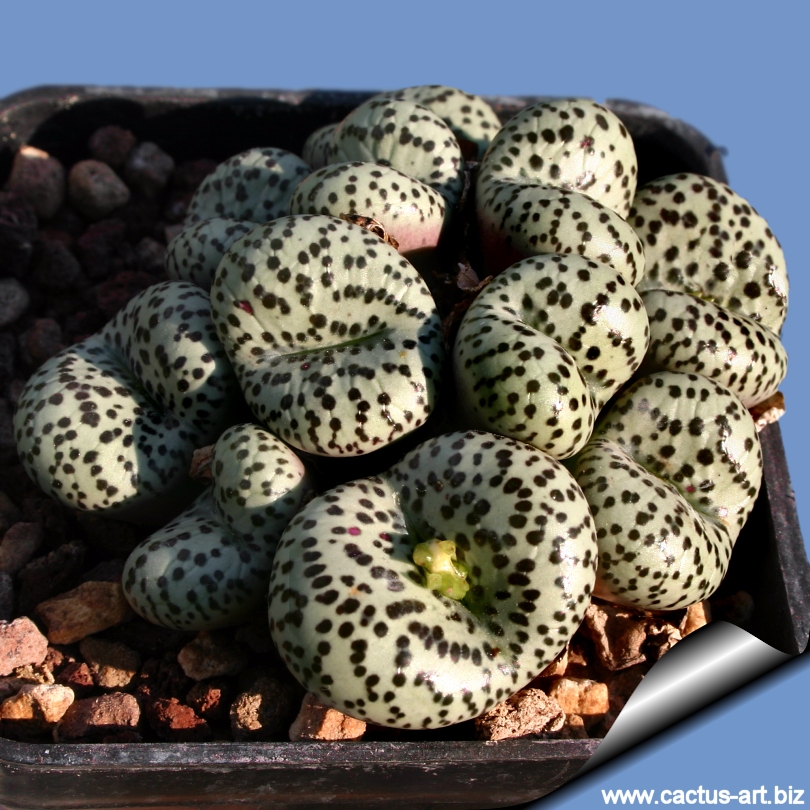 The plants of Conophytum obcordellum vary considerably in relation to the body markings, but also according to the size and depth of colour of the flowers. The nocturnal flowers are exquisitely perfumed. The plants of Conophytum obcordellum vary considerably in relation to the body markings, but also according to the size and depth of colour of the flowers. The nocturnal flowers are exquisitely perfumed.
|
| Description: Dwarf succulent bodies with exquisite markings, these plants are variably caespitose, with single or double bodies, or forming dense mats or cushions.
Profile: Variable bodies, small, pancake-shaped, convex or concave at the apex, about 1 cm in diameter with a small growing cleft that doesn't reach right across the body.
Colour: Silvery-green, variously spotted light or dark brown. The unspotted sides are pink to a deep dark red, while the apex, which is glabrous, medium green, and variably suffused with reddish or dark green dots that are slightly raised, which sometimes join up to make lines and which turn a beautiful bright red during the resting period.
Flowers: Large with a rich pink-creamy colour and a pale yellow centre. The thin petals form an almost star-like, spidery structure, they are aromatic and very showy:
Blooming season: Blooms mostly Aug-Nov. The flowers are numerous and open at night.
Point of interest: Always present and often prominent markings or raised spots; pinkish (or white) nocturnal flowers in autumn, strongly scented. This species has some (controversial) forms and Varieties. They are: - Conophytum obcordellum f. declinatum (C. declinatum)
- Conophytum obcordellum v. giftbergense (C. giftbergense)
- Conophytum obcordellum f. multicolor (C. multicolor)
- Conophytum obcordellum f. picturatum (C. picturatum)
- Conophytum obcordellum v. spectabile (C. spectabile)
- Conophytum obcordellum f. ursprungianum (C. ursprungianum)
|
Cultivation: C. obcordellum is easy to grow. These plants grow on winter rain and head for summer dormancy. More or less dormant in summer. The plant requires little water; otherwise its epidermis breaks (resulting in unsightly scars). Water throughout the year although minimally in summer, (only when the plant starts shrivelling), but it will generally grow even in summer if given water. Water regularly in winter after the previous year's leaves have dried up. Requires good drainage. Keep cool and shaded from hot sun in mid-summer; it needs full sun or light shade in the other seasons. Hardy to -2°C. Ensure a very good ventilation. Avoid to repot frequently. This plant may stay in the same pot for many years. Plants grown in larger containers have frequently relatively poor flowers. It might improve when the plants are given their own, small individual pots. Propagation: It can be reproduced both by cuttings and seeds. Take the cutting from a grown-up mother plant. Each cutting must contain one or more heads, along with a fraction of root. |
